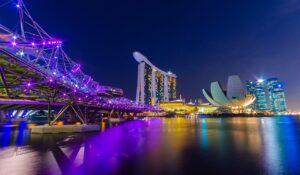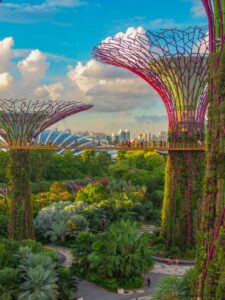2024 brought challenges to the global art market: fewer auctions, hesitant collectors, and gallery closures in some instances. Yet, 2025 begins with a sense of renewal and opportunity, particularly in Singapore.
In this piece, we explore how Singapore is carving out a prominent place in the evolving art landscape.
We spoke to Ying Zhao – our Singapore-based Crown Fine Art lead – about their predictions for the region’s art market in 2025, and why Singapore is one to watch.
A growing presence as a global market player
Sitting at a crossroads of major trade routes and connecting the East to the West, Singapore positions itself as a convenient and accessible hub for art collectors, dealers, and institutions from around the world, aided by its favourable foreign investment policies and robust free-market economy.

This momentum continued in January 2025 with the third edition of Art SG. Hosting 105 galleries from 30 countries and territories and attracting over 41,000 visitors in its four-day run, galleries have reported strong sales to established and emerging art collectors. Most notably, the London-based Cardi Gallery sold Pablo Picasso’s Buste d’Homme à la pipe (1969) for USD 1.2 million, signalling strong interest from serious collectors
With its strategic positioning, growing investment in the arts, and a thriving market, Singapore is solidifying its status as a dynamic global hub for art collectors and enthusiasts alike.
Market resilience amid geopolitical shifts
Rising interest rates and geopolitical tensions strongly challenged the art market last year, with Artsy reporting the top 100 auction lots totalling $1.8 billion—down from $2.4 billion in 2023 and $4.1 billion in 2022. Despite this, the market remains resilient and adaptable.
It’s no secret that the art market is sensitive to global economic conditions, with downturns affecting collectors’ purchasing power. While Singapore provides a neutral and business-friendly environment, regional political developments can impact art flow and collectors – the implementation of stringent national security laws in Hong Kong demonstrated this. While the city’s stability attracts businesses, it must innovate to maintain its competitive edge.
Ying Zhao, Lead of Crown Fine Art Activity in Singapore says: “Collaboration between regions will be crucial going forward to ensure the ongoing success of the Asian art market. Singapore’s free trade zones, excellent transport links, and strategic location give us a real edge. We’re focusing on partnering with local agents to support activity in underdeveloped areas.”
Sustainability takes centre stage
Sustainability is now a central theme in the art world.
Traditionally reliant on air freight and single use packaging, the fine art logistics sector is working to reduce its environmental footprint. The Gallery Climate Coalition suggests that even small changes, such as using the sea freight shipping route between London and Hong Kong instead of air freight, can have a positive impact.
Artists and galleries are increasingly incorporating sustainable materials and themes into their work. For example, Singapore Art Week 2025, which took place in January, featured exhibitions created from recycled materials and eco-friendly installations, highlighting a commitment to environmental consciousness.
Our Crown Fine Art operation in Singapore is making active efforts to limit waste by recycling and reusing packaging materials and searching for stronger recyclable materials for more fragile projects. We also search for opportunities to combine jobs when permission is granted to reduce travel and frequent trips and continue to train staff in the expectations of sustainable practices using industry expertise.
As sustainability becomes a key priority, collaboration across the industry will be essential to drive meaningful change and reduce the environmental footprint of the art market.
Final thoughts
The Singapore art market continues to show promising growth, fuelled by its strategic location and increasing investments in the arts. Despite challenges such as geopolitical uncertainties and economic shifts, the market’s resilience stands out. Additionally, the emphasis on sustainability is encouraging eco-friendly practices within the industry.
By promoting collaboration and prioritizing sustainable initiatives, Singapore can enhance its status as a global art hub, drawing in collectors and creatives from around the world.

